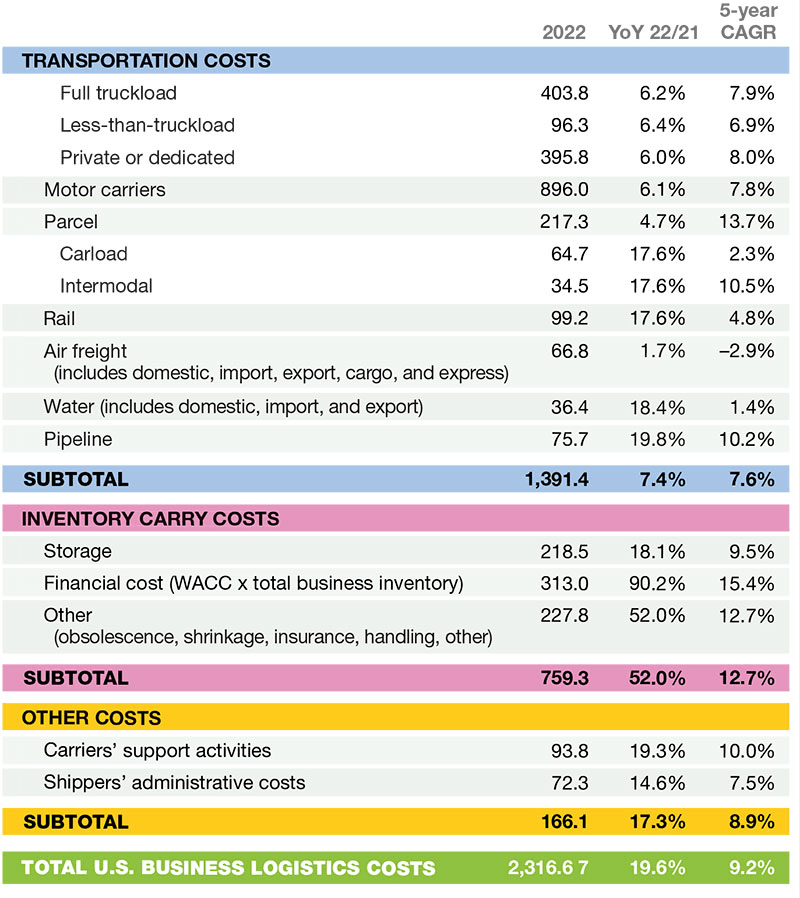
Tel: +86-18666210029 Email: 2881674230@qq.com

Tel: +86-18666210029 Email: 2881674230@qq.com
Global Logistics Challenges 2023: Ocean Freight, Air cargo and third-party logistics
The construction of supply chain no longer takes cost reduction as the only consideration, but pays more attention to the elasticity of supply chain.
The freight industry continues to be the primary driver of the U.S. logistics market.
Third party logistics will continue to scale to strengthen distribution capabilities, and smaller third party logistics companies do not have the corresponding capital reserves.
Supply chain demand is likely to remain stagnant or decrease this year due to "continued uncertainty" in the U.S. and global markets. For the logistics industry, ocean shipping, air cargo and third-party logistics have entered a major consolidation cycle.
| Logistics costs rise in the United States
The Council of Supply Chain Management Professionals (CSCMP) recently released its 34th Annual State of Logistics Report, which states that U.S. commercial logistics costs (USBLC) will reach $2.3 trillion in 2022, an increase of 19.6% to 9.1% of gross domestic product (GDP), compared to 7.5% just two years ago. It's at its highest point since the outbreak was lifted.
Between 2021 and 2022, U.S. commercial logistics costs (in billions of dollars) increased by 19.6%

Note: USBLC stands for United States business logistics costs; YoY represents a year-on-year increase; WACC stands for weighted average cost of capital. The figure includes 5.4% inflation in the 2021 figure. Source: CSCMP 34th Annual State of Logistics Report.
In the face of rising costs, shippers and carriers need to work together to build new "strategic capabilities", which require long-term planning, extensive resources and support from senior management, as well as money and time.
Supply chain demand is likely to remain stagnant or decrease this year due to "continued uncertainty" in the U.S. and global markets. According to the International Monetary Fund, global GDP grew by just 3.1% last year and is expected to grow by 2.9% this year.
The construction of supply chain no longer takes cost reduction as the only consideration, but pays more attention to the elasticity of supply chain. Achieving this flexibility, however, requires trade-offs between core considerations such as speed, service, choice, and cost that become more complex and nuanced over time.
The impact of rising operating costs
Within the United States, the impact of higher inventory operating costs has been dramatic.
Operating costs associated with warehousing goods increased significantly last year due to higher interest rates, with the finance cost of commercial inventory rising 123 percent to $313 billion. Overall inventory costs rose nearly 400 percent to $759 billion. Such a surge is clearly unusual and warrants concern.
Bart de Muinke of project44 said that incidents that disrupt and affect the supply chain will likely continue to increase, and companies need to be flexible and agile in responding to these incidents.
Greg Jarvor of Mattel said that supply chain resilience is now the top trend in the report, and stakeholders should align themselves with this direction of logistics development.
Robert Walpole of Delta Airlines said that global air cargo rates are moving toward a rate of normalization, and supply will exceed demand for a long time, which could be good news for manufacturers and customers. Longshoremen on the West Coast, for example, got a 32 percent raise in 2028, fedex pilots got a 30 percent temporary raise, and Delta Air Lines pilots will see their salaries rise 34 percent over the next four years.
Us transportation patterns in 2022
The freight industry continues to be the main driver driving the US logistics market, broken down by transportation mode, the following is the US commercial logistics express and air freight between 2021 and 2022.
Delivery services increased to $217 billion, up just 4.7% from a year earlier and up 20.1% from 2021. The explosive growth of e-commerce at the peak of the pandemic has returned to pre-pandemic levels as consumers return to physical stores to shop. That could have implications for delivery giants such as UPS and FedEx in the future.
Air cargo remained stable, with domestic revenue reaching $66.8 billion last year, almost unchanged from 2021. Global air cargo revenues are expected to be $150 billion this year, 25% below 2022 levels. One bright spot is the 20 percent drop in fuel costs since April 2022.
In 2022, the market moved sharply in favor of shippers, and this trend has remained largely unchanged in the first half of 2023, with shipper demand and carrier capacity balanced, inventories abundant, and the peak in special demand during the pandemic has temporarily leveled off.
Contact: Miss.Xiang
Phone: +86-18666210029
Tel: +86-18666210029
Email: 2881674230@qq.com
Add: 107-113, Floor 1, Building B3, Jufufufa Industrial Park, Fuyong Subdistrict, Bao'an District, Shenzhen
We chat
